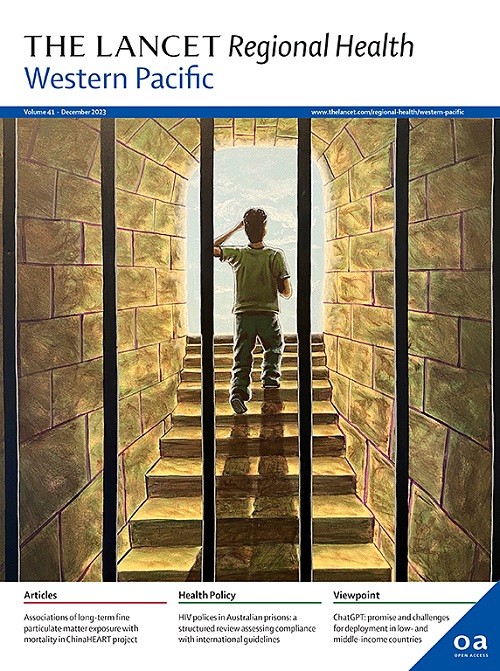1990-2021年中国及各省因危险因素导致的年龄-性别特异性泌尿系统癌症负担及情景模拟预测:基于2021年全球疾病负担研究的系统分析
IF 7.6
1区 医学
Q1 HEALTH CARE SCIENCES & SERVICES
引用次数: 0
摘要
随着全球老龄化的加剧,泌尿系统癌症带来了越来越多的健康和经济负担。在拥有世界五分之一人口的中国,监测这些癌症的分布和决定因素并模拟卫生干预措施的效果对全球和国家卫生至关重要。方法利用全球疾病负担(GBD)中国数据库,分析了中国及其34个省份的发病率、患病率、死亡率、残疾调整生命年(DALYs)、残疾生活年(YLDs)和生命损失年(YLLs)的年龄-性别特异性模式,以及人均国内生产总值(GDPPC)与这些模式的关系。重要的是,我们开创了一个多关注深度学习管道(iTransformer)来模拟泌尿系统癌症、风险因素、GDPPC和人口的时空模式,提供年龄、性别、地点特异性泌尿系统癌症负担的长期预测,并研究风险因素导向干预对其未来负担的影响。从1990年到2021年,中国泌尿系统癌症的发病率和患病率有所增加,导致2021年新增病例266,887例(95%置信区间:205,304-346,033)和159,506,067例(12,236万- 207,447,070),主要由55岁以上的男性驱动。2021年,中国台湾、北京和浙江的泌尿系统癌年龄标准化发病率(ASIR)和年龄标准化患病率最高,凸显了疾病负担的显著地区差异。相反,全国年龄标准化死亡率(ASMR)从1990年的6.5(5.1-7.8)/ 10万人下降到2021年的5.6(4.4 - 7.2)/ 10万人,特别是在吉林[- 166.7%(- 237 - - 64.6)]、西藏[- 135.4%(- 229.1 - - 4.4)]和黑龙江[- 118.5%(- 206.5 - - 4.6)]。具体来说,膀胱癌和睾丸癌的全国ASMR分别下降了32.1%(- 47.9至1.9)和31.1%(- 50.2至7.2),而前列腺癌和肾癌分别上升了7.9%(- 18.4至43.6)和9.2%(- 12.2至36.5)。泌尿系统癌症的年龄标准化DALYs、YLDs和YLLs与ASMR一致。除5岁人群外,所有人群中男性患泌尿系统癌症的负担均高于女性。从地区和省份来看,GDPPC高的省份前列腺癌负担最高,其他省份的主要负担为膀胱癌。2021年泌尿系癌症的主要危险因素为吸烟[占55.1%(42.7-67.4)]、高体重指数[13.9%(5.3-22.4)]、高空腹血糖指数[5.9%(- 0.8 - 13.4)],男性吸烟影响显著,女性高体重指数影响显著。在2022 - 2040年间,尽管泌尿系统癌症的ASMR下降,但ASIR从10.09(9.19-10.99)增加到14.42(14.30-14.54)。值得注意的是,前列腺癌超过膀胱癌成为主要亚类,其中55岁以上的患者ASIR增加最多,这凸显了与年龄相关的泌尿系统癌症负担的转变。实施针对性干预后,吸烟控制对泌尿系统癌症负担的减少最大,主要影响男性膀胱癌(下降- 45.8%)。在女性中,控制吸烟和空腹血糖升高可使泌尿系统癌症的ASMR降低5.3%和5.8%。预测模型的平均均方百分比误差、绝对百分比误差和根均方对数误差分别为0.54±0.22、1.51±1.26和0.15±0.07,表明模型运行良好。泌尿系统癌症呈现老龄化趋势,55岁以上人群发病率增加,使前列腺癌成为最繁重的亚类。此外,泌尿系统癌症负担在年龄、性别和省份之间不平衡。根据我们的研究结果,当局和政策制定者可以改进或量身定制针对特定人群的健康策略,包括促进戒烟、减肥和控制血糖。FundingBill,梅琳达·盖茨基金会。本文章由计算机程序翻译,如有差异,请以英文原文为准。
Age-sex-specific burden of urological cancers attributable to risk factors in China and its provinces, 1990–2021, and forecasts with scenarios simulation: a systematic analysis for the Global Burden of Disease Study 2021
Background
As global aging intensifies, urological cancers pose increasing health and economic burdens. In China, home to one-fifth of the world's population, monitoring the distribution and determinants of these cancers and simulating the effects of health interventions are crucial for global and national health.
Methods
With Global Burden of Disease (GBD) China database, the present study analyzed age-sex-specific patterns of incidence, prevalence, mortality, disability-adjusted life years (DALYs), years lived with disability (YLDs), and years of life lost (YLLs) in China and its 34 provinces as well as the association between gross domestic product per capita (GDPPC) and these patterns. Importantly, a multi-attentive deep learning pipeline (iTransformer) was pioneered to model the spatiotemporal patterns of urological cancers, risk factors, GDPPC, and population, to provide age-sex-location-specific long-term forecasts of urological cancer burdens, and to investigate the impacts of risk-factor-directed interventions on their future burdens.
Findings
From 1990 to 2021, the incidence and prevalence of urological cancers in China has increased, leading to 266,887 new cases (95% confidence interval: 205,304–346,033) and 159,506,067 (12,236,0000–207,447,070) cases in 2021, driven primarily by males aged 55+ years. In 2021, Taiwan, Beijing, and Zhejiang had the highest age-standardized incidence rate (ASIR) and age-standardized prevalence rates of urological cancer in China, highlighting significant regional disparities in the disease burden. Conversely, the national age-standardized mortality rate (ASMR) has declined from 6.5 (5.1–7.8) per 100,000 population in 1990 to 5.6 (4.4–7.2) in 2021, notably in Jilin [−166.7% (−237 to −64.6)], Tibet [−135.4% (−229.1 to 4.4)], and Heilongjiang [−118.5% (−206.5 to −4.6)]. Specifically, the national ASMR for bladder and testicular cancers reduced by −32.1% (−47.9 to 1.9) and −31.1% (−50.2 to 7.2), respectively, whereas prostate and kidney cancers rose by 7.9% (−18.4 to 43.6) and 9.2% (−12.2 to 36.5). Age-standardized DALYs, YLDs, and YLLs for urological cancers were consistent with ASMR. Males suffered higher burdens of urological cancers than females in all populations, except those aged <5 years. Regionally and provincially, high GDPPC provinces have the highest burden of prostate cancer, while the main burden in other provinces is bladder cancer. The main risk factors for urological cancers in 2021 are smoking [accounting for 55.1% (42.7–67.4)], high body mass index [13.9% (5.3–22.4)], and high fasting glycemic index [5.9% (−0.8 to 13.4)] for both males and females, with smoking remarkably affecting males and high body mass index affecting females. Between 2022 and 2040, the ASIR of urological cancers increased from 10.09 (9.19–10.99) to 14.42 (14.30–14.54), despite their ASMR decreasing. Notably, prostate cancer surpassed bladder cancer as the primary subcategory, with those aged 55+ years showing the highest increase in ASIR, highlighting the aging-related transformation of the urological cancer burden. Following the implementation of targeted interventions, smoking control achieved the greatest reduction in urological cancer burden, mainly affecting male bladder cancer (−45.8% decline). In females, controlling smoking and high fasting plasma glucose reduced by 5.3% and 5.8% ASMR in urological cancers. Finally, the averaged mean-square-Percentage-Error, absolute-Percentage-Error, and root-mean-square Logarithmic-Error of the forecasting model are 0.54 ± 0.22, 1.51 ± 1.26, and 0.15 ± 0.07, respectively, indicating that the model performs well.
Interpretation
Urological cancers exhibit an aging trend, with increased incidence rates among the population aged 55+ years, making prostate cancer the most burdensome subcategory. Moreover, urological cancer burden is imbalanced by age, sex, and province. Based on our findings, authorities and policymakers could refine or tailor population-specific health strategies, including promoting smoking cessation, weight reduction, and blood sugar control.
Funding
Bill & Melinda Gates Foundation.
求助全文
通过发布文献求助,成功后即可免费获取论文全文。
去求助
来源期刊

The Lancet Regional Health: Western Pacific
Medicine-Pediatrics, Perinatology and Child Health
CiteScore
8.80
自引率
2.80%
发文量
305
审稿时长
11 weeks
期刊介绍:
The Lancet Regional Health – Western Pacific, a gold open access journal, is an integral part of The Lancet's global initiative advocating for healthcare quality and access worldwide. It aims to advance clinical practice and health policy in the Western Pacific region, contributing to enhanced health outcomes. The journal publishes high-quality original research shedding light on clinical practice and health policy in the region. It also includes reviews, commentaries, and opinion pieces covering diverse regional health topics, such as infectious diseases, non-communicable diseases, child and adolescent health, maternal and reproductive health, aging health, mental health, the health workforce and systems, and health policy.
 求助内容:
求助内容: 应助结果提醒方式:
应助结果提醒方式:


